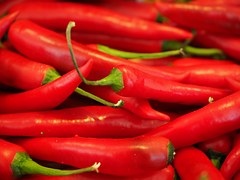 Natural Insight
Natural Insight
Cascading Capsaicin
By Sabeen Faquir
The weather may be cooling down but I think it’s time to heat things up! We all know heat can bring relief to sore muscles. But did you know topical capsaicin (the active ingredient in cayenne and spicy chili peppers) can help ease inflammation, too? And internally, it can have several different effects.
Capsaicin works by signaling to the central nervous system. Particularly, it first increases the sensation of burning or pain. In a study where these pain receptors were cloned it was found that these receptors also respond to thermal stimuli (Caterina et al). Topical capsaicin is a great alternative for those suffering from pain due to chronic neuropathic pain, arthritis, and other ailments who don’t want to use topical steroids.
Capsaicin first increases a burning sensation, and then relieves it. An 8% concentration patch can be used one time to relieve pain for 12 weeks, in those adults with chronic neuropathic pain (Derry et al). Per WebMD, capsaicin may also relieve pain from: surgery, cluster headaches, skin conditions (psoriasis), mouth sores from chemotherapy or radiation. But, capsaicin is never to be used on broken skin.
Capsaicin effectively defunctionalizes cutaneous nociceptors (Derry et al). This means that it defunctionalizes the sensation of heat, with recurrent use. So, while you may experience an itching or burning sensation the first few times you use topical capsaicin, continual use will mitigate this reaction.
Taken as a capsule, capsaicin induces digestive enzymes in both the stomach and pancreas. Particularly, it was found to enhance pancreatic lipase activity and stimulate pancreatic amylase and trypsin and chymotrypsin, when combined with other spices in albino rats (Platel and Srinivasan). Together, these enzymes help us break down fats, carbohydrates, and proteins.
The NIH also found capsaicin to be a strong anti-microbial against Streptococcus pyogenes, a pathogen that can cause histological or systemic infections (Marini et al). Not only was it bactericidal when tested in-vitro, but it inhibited intracellular invasion and haemolytic activity or the loss of red blood cells. It can also prevent the growth of pathogens that cause gingivitis in the mouth and work as an auxiliary treatment for periodontitis, a gum infection that destroys bone (Zhou et al).
Internally, capsaicin can thin mucus. Essentially, it can help clear the lungs of excess mucus and be an auxiliary treatment for people suffering from emphysema, too. Capsaicin inhibits the activation of mast cells that trigger the secretion of histamine, cytokines and other granules that metabolize arachidonic acid, a precursor to both inflammatory and anti-inflammatory fats (Frydas et al).
So, if you want to use heat to help you find relief from sore muscles, bad digestion, bacterial infections, or more, try capsaicin. But, before beginning any supplement regimen, remember to talk to your doctor to be certain there will be no interaction with any underlying condition you may have.
Disclaimer: The content of this article is not intended to diagnose, treat, prevent, or cure disease.
Sources:
Michael J. Caterina, Mark A. Schumacher, Makoto Tominaga, Tobias A. Rosen, Jon D. Levine and David Julius. The capsaicin receptor: a heat-activated ion channel in the pain pathway. Nature 389, 816-824 (23 October 1997)
Sheena Derry, Andrew S C Rice, Peter Cole, Toni Tan, R Andrew Moore. Topical capsaicin (high concentration) for chronic neuropathic pain in adults. Cochrane Library: Cochrane Database of Systematic Reviews. 28 February 2013
- Platel, K. Srinivasan. Influence of dietary spices and their active principles on pancreatic digestive enzymes in albino rats. Molecular Nutrition & Food Research. Volume 44, Issue 1, 1 January 2000, Pages 42–46
Emanuela Marini, Gloria Magi, Marina Mingoia, Armanda Pugnaloni, and Bruna Facinelli. Antimicrobial and Anti-Virulence Activity of Capsaicin Against Erythromycin-Resistant, Cell-Invasive Group A Streptococci. Frontiers in Microbiology. 2015; 6: 1281
- Zhou, X. Guan, W. Zhu, Z. Liu, X. Wang, H. Yu, H. Wang. Capsaicin inhibits Porphyromonas gingivalis growth, biofilm formation, gingivomucosal inflammatory cytokine secretion, and in vitro osteoclastogenesis. European Journal of Clinical Microbiology & Infectious Diseases, 2014, 33, 2, 211-219
Frydas, G. Varvara, G. Murmura, A. Saggini, A. Caraffa, P. Antinolfi, S. Tetè, D. Tripodi, F. Conti, E. Cianchetti, E. Toniato, M. Rosati, L. Speranza, A. Pantalone, R. Saggini, L.M. Di Tommaso, T.C. Theoharides, P. Conti, F. Pandolfi. Impact of Capsaicin on Mast Cell Inflammation. International Journal of Immunipathology and Pharmacology. July 2013 vol. 26 no. 3 597-600

